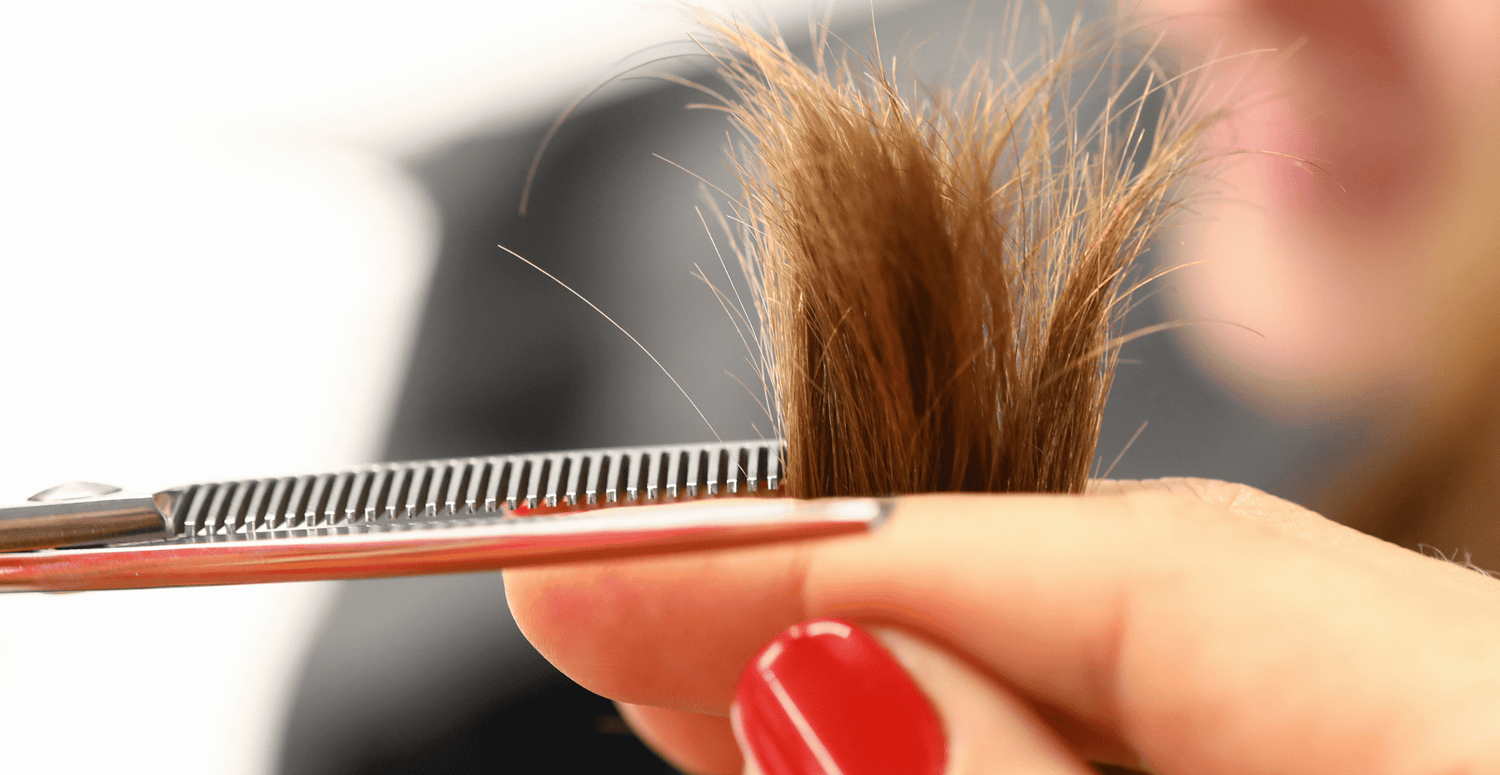Split ends are a common problem for both men and women. These pesky little tips can make your hair look dry and unhealthy, and they can even lead to more serious hair damage if left untreated. In this blog post, we'll discuss what causes split ends, the different types of split ends, and how to prevent split ends in men and women - including how to prevent split ends in beards.
What causes split ends?

Split ends, also known as trichoptilosis, occur when the protective cuticle layer around the hair shaft becomes damaged. If you're facing a problem with split ends it is best to consult doctor who can provide the exact cause and preventive measure to reduce it. At Clinikally, we provide dermatologist online consultation if This can happen for a variety of reasons, including:
-
Overuse of heat-styling tools: Flat irons, curling irons, and blow dryers can all cause damage to the hair shaft if used excessively or at high temperatures.
-
Chemical treatments: Perms, straightening treatments, and dyes can all strip the hair of its natural oils, leading to dryness and split ends.
-
Poor nutrition: A diet lacking in essential nutrients can lead to weak and brittle hair, making it more prone to split ends.
-
Environmental factors: Exposure to the sun, wind, and pollution can all damage the hair and cause split ends.
Preventing split ends necessitates a multifaceted approach that includes regular trims, gentle hair care techniques, adequate conditioning, and defensive measures to reduce damage from external sources. Maintaining a healthy lifestyle and eating a balanced diet can also help with overall hair health.
The role of environmental factors in causing split ends
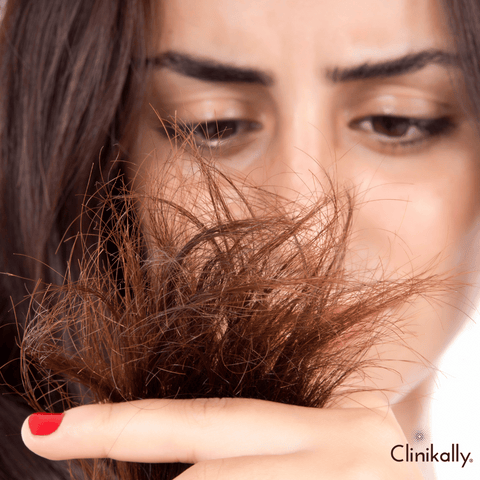
Split ends, also known as trichoptilosis, happen when the hair cuticle's protective outer layer is damaged or wears away, causing the hair to break into two or more strands. Although there are many reasons why split ends occur, environmental factors are a major contributor to their development. The following are some of the most significant environmental components:
-
UV Radiation: The sun's ultraviolet (UV) radiation can damage the hair cuticle, causing dryness and breakage. Without protection, prolonged exposure to sunlight can weaken the hair shaft and contribute to the formation of split ends.
-
Extreme Weather Conditions: Extreme weather conditions, such as strong winds, cold temperatures, and low humidity, can strip the hair of its natural moisture, making it more prone to breakage and split ends. Dry and cold air, in particular, can dehydrate the hair, increasing its susceptibility to damage.
-
Heat Styling: Excessive use of heat-styling tools such as flat irons, curling irons, and blow dryers can cause damage to the hair cuticle. High temperatures can strip the hair of its natural moisture, resulting in dryness, brittleness, and, eventually, split ends.
-
Chemical Exposure: Harsh chemicals, such as those found in some hair dyes, relaxers, and perming solutions, can weaken the hair structure and contribute to split ends. Chemical treatments can strip the hair of its natural oils and protective layers if it is overprocessed.
-
Hard Water: Water with a high mineral content, also known as hard water, can be harmful to hair health. Hard water minerals can deposit on the hair shaft, making it more susceptible to damage and split ends over time.
-
Poor Air Quality: Toxins and pollutants in the air can settle on the hair, causing damage and dryness. Polluted air can contribute to oxidative stress, which can hurt hair health.
Consider the following suggestions to avoid split ends caused by environmental factors:
-
Wear hats or scarves to protect your hair from harsh weather conditions, especially during extreme temperatures or strong winds.
-
To reduce the harm that sun exposure causes, use UV-protective hair care products.
-
Use a heat protectant before styling at all times, and cut back on the frequency of using heat styling tools.
-
Use moisturising shampoos and conditioners to keep your hair properly hydrated. Treatments for deep conditioning the hair can also aid in its moisture restoration.
-
To remove split ends and stop them from climbing the hair shaft, trim your hair regularly.
By keeping an eye out for these environmental influences and practising proper hair care, you can reduce the likelihood of split ends and keep your hair looking healthier.
Impact of chemical treatments and heat styling
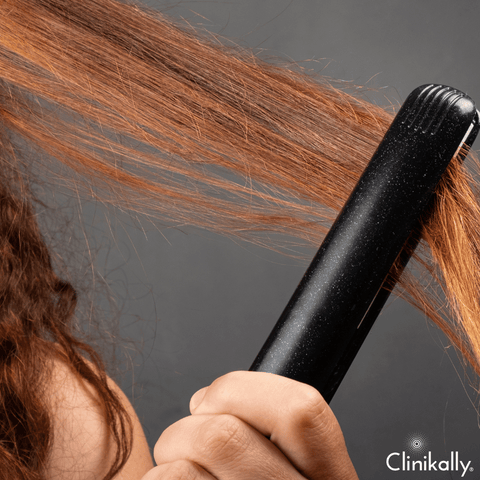
Chemical treatments and heat styling can have an influence on hair in both positive and negative ways, depending on how they are used and the overall care provided. Chemical treatments and heat styling have the following impacts on hair:
Chemical Treatments:
Positive Impacts:
-
Coloring and highlights: Coloring hair can give you the desired look, allowing you to express yourself creatively and hide grey areas.
-
Relaxers and Perms: These hair treatments have the power to change the texture of hair, giving people the chance to wear a variety of looks.
Negative Impacts:
-
Dryness and Damage: Chemical treatments have the potential to deplete hair of its natural oils, causing dryness and increasing the likelihood of split ends and breakage.
-
Weakening of Hair Structure: Harsh chemicals used in some treatments may weaken the protein structure of the hair, making it more prone to breakage and elasticity loss.
-
Reactions Allergic: The chemicals in hair dyes and other treatments can cause allergic reactions in certain people.
-
Color Fading: Coloured hair can fade over time, especially if it is washed frequently or exposed to the sun.
Heat Styling:
Positive Impacts:
-
Versatility in Styling: There are many different styling options available, ranging from curling to straightening, thanks to heat styling tools like blow dryers, curling irons, and flat irons.
-
Temporary Modifications: Heat styling gives hair texture and style momentary modifications that allow for a variety of looks.
Negative Impacts:
-
Dryness and Breakage: Overheating can deplete hair's natural moisture content, which can cause brittleness, breakage, and dryness.
-
Split Ends: The development of split ends can be attributed to the extended use of heat-styling tools without the appropriate protection.
-
Heat Damage: High temperatures can damage the cuticle of the hair, affecting its overall health and appearance.
-
Color Fading: When it comes to colored or chemically treated hair, heat styling can exacerbate hair color fading.
Mitigation and Prevention:
Take into account the following advice to reduce the harmful effects of heat styling and chemical treatments:
-
Employ Heat Protectants: To minimise hair damage and establish a barrier, use heat protectant products before using heat-styling tools.
-
Limit Frequency: To reduce heat-related damage, do not use heat styling tools excessively, and occasionally let your hair air dry.
-
Deep Conditioning: After chemical treatments in particular, use deep conditioning treatments to nourish and moisturise the hair.
-
Frequent Trims: To get rid of split ends and stop additional damage, schedule routine trims.
-
Select Professional Services: To reduce the risk of damage, hire a professional if you decide to use chemical treatments.
-
Observe Instructions: To guarantee correct application and lower the possibility of unfavourable effects, adhere to the instructions supplied with chemical treatments.
Individuals can enjoy the benefits of chemical treatments and heat styling while minimising potential damage to their hair by taking these precautions and adopting a balanced approach.
What are the types of split ends?

Split ends can come in different shapes and sizes, depending on the degree of damage to the hair shaft. Some common types of split ends include:
-
Single-strand split ends: These are the most common type of split ends, and occur when a single strand of hair splits into two or more strands.
-
Multiple-strand split ends: This type of split end occurs when multiple strands of hair split into smaller strands, creating a frayed or fuzzy appearance.
-
Split ends with a hook: This type of split end has a hook-like shape at the end, which can make it difficult to comb or brush the hair.
It's vital to emphasise that these are observational and descriptive descriptions rather than scientifically categorised categories. Split ends are caused by a variety of conditions, including heat styling, chemical treatments, mechanical damage, and environmental stressors. Split ends, regardless of their appearance, can be minimised and prevented with regular trims and correct hair care techniques.
Identifying different patterns of split ends
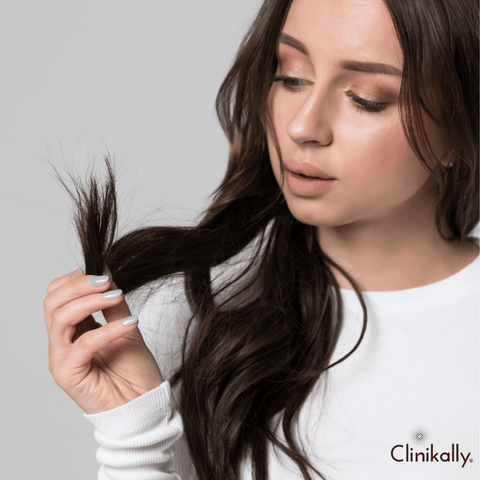
Split ends can appear in a variety of patterns, and identifying them can help you understand the precise causes and conditions impacting your hair. Here are some examples of split end patterns:
-
Basic Split End: At the end, the hair strand divides into two separate strands. Normal wear and tear, exposure to environmental factors, and poor hair care are all common causes.
-
Feathered Split End: The split does not appear to be clean; rather, it appears ragged or feathered. Excessive heat stress, chemical damage, or a combination of factors are usually to blame.
-
Multiple Split Ends (Forking): The hair breaks into more than two strands at the end, creating a forked appearance. Long-term neglect, a lack of regular trimming, and exposure to environmental stresses are all common causes.
-
Miniature Split Ends (White Dots): Small white spots or specks at the end of the hair strand indicate minor damage. Minor damage, friction, or the use of harsh hair accessories can all contribute to this.
-
Deep or Incomplete Split: Instead of being limited to the tip, the split goes deeper up the hair shaft. Excessive heat, chemical treatments, or forceful brushing can cause severe damage.
-
Tree-Like Split End (Tree Trunk Split): The split resembles the branches of a tree, with several splits radiating from a single point. A combination of circumstances, including excessive heat, chemical treatments, and long periods of neglect, can result in severe damage.
-
Single Strand Knot: When a hair strand forms a structure resembling a knot, it may tangle and break. This is a common condition in hair that is textured or curly, and handling that is too harsh or dry can exacerbate it.
-
Tapered Split End: The hair appears tapered because of the gradual split that occurs along its length. As a result of unequal exposure to potentially hazardous stimuli, such as uneven heat distribution during styling.
To effectively identify and address split ends, follow these steps:
-
Inspections regularly: Examine the ends of your hair strands regularly for signs of splitting or damage.
-
Professional Evaluation: Consult a hairstylist for a professional evaluation and advice on the best course of action.
-
Preventive Measures: To avoid split ends, use preventive measures such as regular trims, deep conditioning treatments, and protective styling.
By recognising split end patterns, you can tailor your hair care routine to address specific issues while also promoting overall hair health.
The relationship between hair type and split ends

Several variables influence the relationship between hair type and split ends, including the natural properties of different hair types and how they respond to various environmental and styling influences. Here's a rundown of how different hair types may be linked to split ends:
-
Straight Hair: Straight hair has a smooth, flat cuticle surface that can reflect light and make it appear shiny. Straight hair is less likely to tangle, but it is not immune to split ends. Damage and broken ends can still be caused by environmental conditions, heat style, and chemical treatments.
-
Wavy Hair: Wavy hair is textured in a way that is somewhere between straight and curly, with a subtle wave pattern. Wavy hair is more prone to frizz and tangling, especially if it is dry. This can lead to split ends. However, with good care, including regular conditioning, the danger can be reduced.
-
Curly Hair: Curly hair has a characteristic spiral or coiled pattern and is porous in comparison to straight hair. Because of its structure, curly hair is more prone to dryness and frizz. Natural oils produced by the scalp have a more difficult time travelling down the hair shaft, making the ends more susceptible to dryness, breakage, and split ends. Gentle handling and moisturising are essential for the health of curly hair.
-
Coily/Kinky Hair: Coily or kinky hair is distinguished by tight, spiral curls or coils and a more delicate structure. Coily and kinky hair types are prone to dryness and breakage because natural oils have a difficult time travelling down the hair shaft. Moisture retention is essential, and protective styles can aid in the prevention of split ends.
-
Fine Hair: Fine hair has a smaller diameter and may be more sensitive in individual strands. Because fine hair lacks the thickness and strength of coarser hair, it is more prone to damage, including split ends. Gentle style and avoiding excessive heat are essential for keeping fine hair healthy.
-
Thick/Coarse Hair: Hair that is thick or coarse has a bigger diameter and is more robust. While thick hair is more resilient, it can still develop split ends, especially if subjected to rigorous style or chemical treatments. Split ends in thick hair can be avoided with regular trims and careful maintenance.
General Split End Prevention Advice:
-
Trims regularly will help to remove split ends and keep them from travelling up the hair shaft.
-
Maintain adequate moisture in your hair, especially at the ends. Apply deep conditioning treatments and conditioners.
-
Consider using protective styles to reduce exposure to environmental factors and manipulation.
-
Handle the hair gently, especially when wet, to avoid breakage and split ends.
Understanding your hair type and its specific needs can help you tailor your hair care routine to prevent split ends and keep your hair looking healthy and beautiful.
Tips to prevent split ends in men and women
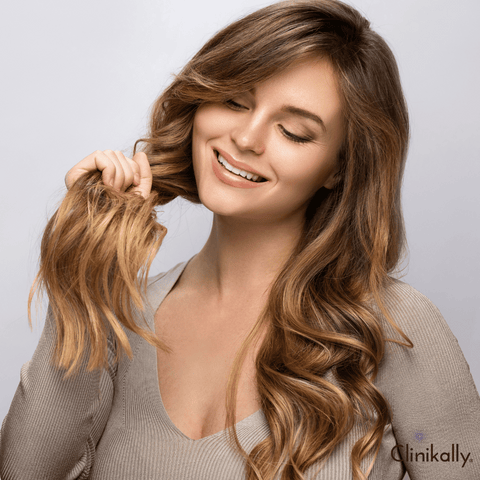
With the right hair care routine and dermatologist-recommended hair care products, it is possible to effectively reduce split ends of all types.
How to reduce split ends in hair naturally

Adopting good hair care techniques and combining nourishing components from natural sources are essential for naturally reducing split ends in hair. If you're looking to reduce split ends in your hair naturally, there are several things you can do:
-
Avoid using heat-styling tools: Instead, try using natural methods of styling, such as braiding or twisting your hair.
-
Use a leave-in conditioner: A leave-in conditioner can help to moisturize and protect the hair, reducing the chances of split ends forming.
-
Use a natural oil: Olive oil, argan oil, or coconut oil for hair can all help to nourish and moisturize the hair, reducing split ends.
-
Avoid brushing or combing your hair when it's wet: Wet hair is more susceptible to breakage, so it's best to let your hair dry naturally before brushing or combing it.
-
Consult dermatologists online: You can consult the best dermatologists in India for expert advice that you can trust. This will help you prevent split hair through personalised and targeted treatment.
Remember that consistency is essential while using natural medicines. Experiment with numerous options to find the ideal routine for your hair type and preferences.
How to prevent split ends in curly hair

Curly hair is particularly susceptible to split ends, as the natural curls can cause the hair to break or tangle more easily. Here are some tips for preventing split ends in curly hair:
-
Use a wide-tooth comb: A wide-tooth comb can help to gently detangle curly hair, reducing the chances of split ends.
-
Avoid heat-styling tools: Curly hair is already prone to dryness, so avoid using heat-styling tools as much as possible.
-
Use a deep conditioning treatment: A deep conditioning treatment can help to nourish and moisturize curly hair, reducing the chances of split ends. You can buy dermatologist-recommended hair care products from a trusted online pharmacy and get free delivery to your doorstep.
-
Avoid brushing or combing your hair when it's dry: Dry hair is more susceptible to breakage, so it's best to brush or comb your hair when it's damp.
You can help prevent split ends and maintain the general health and beauty of your curly hair by following these guidelines and adjusting your hair care regimen to the specific needs of your curls.
How to prevent split ends in beard

Just like the hair on your head, your beard can also develop split ends. To prevent split ends in your beard, try the following:
-
Use a beard oil or conditioner: A beard oil or conditioner can help to moisturize and protect the hair in your beard, reducing the chances of split ends.
-
Avoid heat-styling tools: Heat-styling tools, such as blow dryers, can damage the hair in your beard and cause split ends.
-
Use a beard comb or brush: A beard comb or brush can help to evenly distribute the natural oils in your beard, keeping it healthy and reducing split ends.
-
Avoid using harsh chemicals: Harsh chemicals, such as those found in some hair dyes, can damage the hair in your beard and cause split ends.
You may help avoid split ends and keep your beard looking healthy and well-groomed by implementing these methods into your daily regimen. Adjust your routine based on your beard's individual needs and how it reacts to different products and methods.
Protect hair from split ends!

Split ends can be a frustrating problem, but with the right care and attention, you can prevent and reduce them naturally. By avoiding heat-styling tools, using natural oils and conditioners, and using the right brushing and combing techniques, you can keep your hair and beard healthy and free of split ends. So take care of your hair, and protect it from split ends!
Best practices for hair brushing and detangling
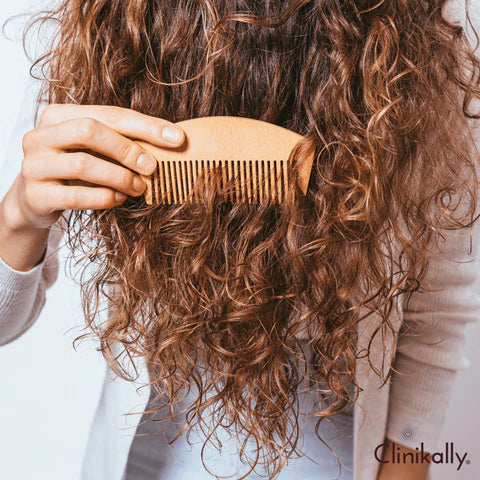
Hair brushing and detangling are essential components of a healthy hair care routine. The following are some best practises to follow:
-
Start with the Right Tools: To detangle, use a wide-tooth comb or a brush with flexible, widely spread bristles. Choose a brush appropriate for your hair type for frequent brushing (e.g., paddle brush for straight hair, detangling brush for curly hair).
-
Brush Before Washing: Detangle your hair before washing it to reduce breakage when it is wet. To make the process go more smoothly, use a leave-in conditioner or detangling spray.
-
Section Your Hair: Make sections in your hair, especially if you have thick or long hair. This makes detangling easier and prevents hair from being yanked.
-
Start from the Tips: Begin detangling your hair at the tips or ends and work your way up. Gradually work through knots, rather than pulling through them from the roots.
-
Use Light Strokes: Brush or comb your hair gently downward. Brushing too hard or too quickly can cause breakage and split ends.
-
Be Patient: Take your time detangling your hair, especially if it is prone to tangling. Rushing through the process can be detrimental.
-
Detangle When Wet: When hair is wet, it becomes more flexible and less prone to breakage. In the shower, start at the tips and work your way up with a wide-tooth comb or a detangling brush.
-
Apply Conditioner: Use a high-quality conditioner to give your hair slip, making it easier to detangle. Apply conditioner primarily to the ends, which are prone to knot formation.
-
Avoid Brushing Wet Hair: Wet hair is more prone to breakage, so avoid using a brush on it. Brush wet hair with a wide-tooth comb or a detangling brush if necessary.
-
Protective Hairstyles: Consider protective hairstyles, especially at night, to keep your hair from tangling. Loose braids or a satin/silk scarf are examples of this.
-
Clean Your Brushes: Clean your brushes and combs regularly to remove accumulated hair, oils, and styling products. Clean tools are more efficient.
-
Trim Regularly: Trims regularly help to prevent split ends and tangling. Trim your hair every few months, or as needed, depending on the condition of your hair.
-
Choose the Right Products: Use hair care products that are appropriate for your hair type and address specific issues such as frizz or dryness.
-
Avoid Tying Tight Hairstyles: Tight hairstyles may cause tangling and breakage. Choose loose styles when sleeping or engaging in physical activities.
You can reduce damage and breakage and maintain healthier, more manageable hair by incorporating these best practises into your hair care routine.
Choosing the right hair care products for split end prevention
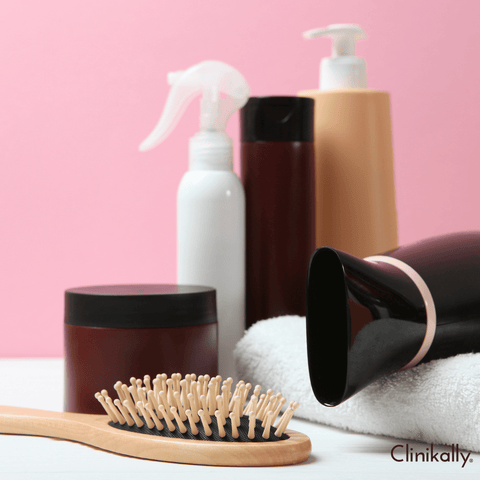
Choosing the appropriate hair care products is critical for preventing split ends and preserving overall hair health. Here are some important factors to consider when selecting products for split end prevention:
-
Moisturizing Shampoo and Conditioner: To keep your hair hydrated, use a moisturising shampoo and conditioner. Look for glycerin, hyaluronic acid, and natural oils like argan oil, coconut oil, or jojoba oil in your products. Split ends are less common in moisturised hair.
-
Sulfate-Free Formulas: Choose sulfate-free shampoos because sulphates can strip the hair of its natural oils, causing dryness and increased susceptibility to split ends.
-
Deep Conditioning Treatments: Include deep conditioning treatments in your regimen. Select hair care products that contain nourishing ingredients such as protein, keratin, or shea butter to fortify hair and minimise breakage.
-
Leave-In Conditioners: Use leave-in conditioners to provide ongoing moisture and protection. Look for lightweight formulas that will not weigh down your hair.
-
Heat Protectants: Always use a heat protectant spray or serum when using heat styling tools to protect your hair from the damaging effects of high temperatures.
-
Split End Repair Products: Look for products that are specifically designed to repair split ends. These may contain ingredients such as amino acids, keratin, or silicone to temporarily seal the cuticle and improve the appearance of split ends.
-
Protein Treatments: Protein treatments can help to strengthen the hair shaft. Proteins such as keratin can aid in the restoration of damaged areas and improve the overall integrity of the hair.
-
Avoiding Harsh Chemicals: Choose products that are free of harsh chemicals like sulphates, parabens, and phthalates. Dryness and damage can be exacerbated by harsh chemicals.
-
Hair Oils: Incorporate natural oils such as argan oil, coconut oil, or jojoba oil into your routine. These hair oils can give hydration and nutrients to your hair.
-
Vitamin-Enriched Products: Look for products that contain vitamins like vitamin E, B vitamins, and biotin, which can help with overall hair health.
-
pH-Balanced Products: Use pH-balanced products to keep the hair's natural acidity, which helps the cuticle's health.
-
Avoiding Overwashing: Reduce the frequency with which you wash your hair, as this can strip away natural oils. Most people can get away with washing every 2-3 days or as needed.
-
Regular Trims: Regular trims, while not a product, are essential for preventing split ends. Trim your hair every few months to remove damaged ends and keep it healthy.
-
Choosing Products Based on Hair Type: When choosing products, keep your hair type in mind. Different hair types have different needs, and tailoring your products to your specific hair type can help them work better.
Before investing in new products, it's important to understand your hair's specific demands, whether they're dryness, frizz, or something else. Experimenting with several products and changing your routine based on your hair's response might assist you in determining the most efficient split end prevention technique.





